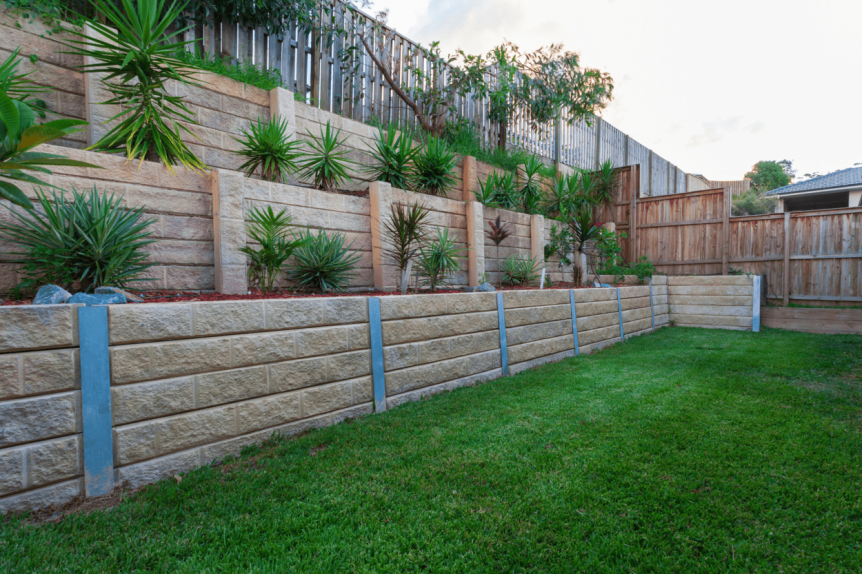What are Retaining Walls?
Think of retaining walls as the barriers of Sydney’s gardens and outdoor spaces, built from various retaining wall materials like stone, concrete, or wood.
Retaining Walls hold back dirt and soil, stopping it from moving or falling away. They help keep the ground in place so it doesn’t wash away with the rain or collapse. These walls, along with granite pavers, are great for levelling sloped areas. They’re perfect for making gardens, yards, or cozy spots to enjoy the view.
By choosing the right materials, these walls do a great job holding back soil and adding beauty as well as strength to any outdoor area.
Why Are Retaining Walls Important In Landscaping And Construction Projects?
Retaining walls safeguard against soil erosion and transform sloped land into terraced yards, gardens, and usable outdoor living spaces. Beyond their functionality, retaining walls also contribute to enhancing the aesthetic appeal of any environment.
By adding structure and definition to outdoor spaces, they create attractive landscapes. Additionally, these walls offer opportunities for creative design elements, such as incorporating various materials, textures, and planting schemes, elevating the beauty of outdoor areas.

Types of Retaining Walls & Choosing the Right Material
-
Gravity Retaining Walls:
Retaining walls made of gravity relies on their ability to withstand the pressure from the soil behind them. Typically constructed from stone, concrete, or other heavy materials, they are ideal for stabilising slopes and creating level areas in gardens and landscapes.
-
Cantilever Retaining Walls:
Cantilever retaining walls are more complex and are made with a strong concrete slab deep into the ground. This design helps them push back against the pressure from the soil, making them a solid choice for building taller walls in Sydney’s different types of land.
-
Sheet Pile Retaining Walls:
Sheet pile retaining walls are best suited for soft soils and tight spaces. Made from steel, wood, or vinyl sheets driven deep into the ground, they offer a temporary solution in waterfront properties or as foundational supports.
-
Anchored Retaining Walls:
Anchored walls provide additional strength through cables or other supports anchored into the rock or soil behind them. This method is particularly effective in combating high loads or walls requiring minimal visible structure.
-
Gabion Retaining Walls:
Gabion walls, with their distinctive cages filled with rocks or concrete, offer a unique aesthetic and environmentally friendly option. They are highly permeable, reduce water pressure, and blend seamlessly into natural landscapes, making them perfect for Sydney’s scenic views.
Benefits of Retaining Walls:
-
Erosion Control
One of the main benefits of retaining walls is their ability to prevent soil erosion, protecting landscapes from being washed away by rainwater.
-
Creation of Usable Space
Retaining walls can transform steep slopes into terraced levels, maximising usable outdoor space for gardens, patios, or additional parking.
-
Improved Aesthetics
Beyond functionality, retaining walls can be designed as stunning landscape features, enhancing the beauty of a property.
-
Support for Structures and Landscapes
Retaining Walls provide essential support to structures and landscapes, preventing the downward movement of soil and maintaining the area’s integrity.
-
Prevention of Soil Movement
Retaining walls are crucial in preventing soil movement, safeguarding properties and landscapes from potential damage.

General step-by-step of the construction process:
1. Planning and Design Considerations
Successful construction of retaining walls in Sydney begins with meticulous planning and design, considering the land’s soil type, slope, and intended use.
2. Site Preparation
Then, proper site preparation is crucial, involving the removal of debris and the stabilisation of the ground.
3. Installation
Each type of retaining wall requires specific installation techniques, from the placement of gravity walls to the anchoring of reinforced walls, consult an expert to determine the best technique for your project.
4. Drainage Solutions
Consider that effective drainage is essential to prevent water build-up behind the wall, which could lead to pressure and potential failure.

Maintenance Tips for Longevity
Regular maintenance, including inspecting for cracks or signs of movement and ensuring drainage systems are clear, can significantly extend the life of a retaining wall.
Incorporating retaining walls into landscape design is not just about solving erosion or soil retention issues; it’s about creating beautiful, functional spaces that last.
Whether you’re a homeowner, landscaper, or involved in construction, understanding the types, materials, and construction methods of retaining walls is key to making informed decisions for your projects. Inquire about our paving and landscaping services today!

